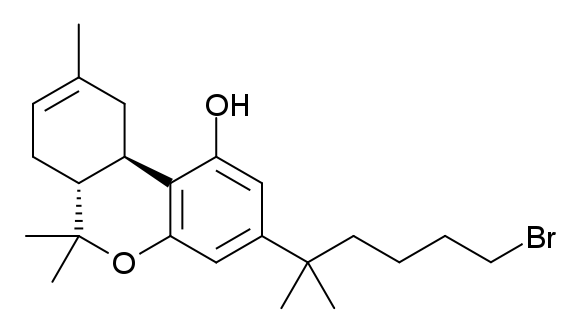|
AM-2233
AM-2233 is a drug that acts as a highly potent full agonist for the cannabinoid receptors, with a ''K''i of 1.8 nM at CB1 and 2.2 nM at CB2 as the active (''R'') enantiomer. It was developed as a selective radioligand for the cannabinoid receptors and has been used as its 131I derivative for mapping the distribution of the CB1 receptor in the brain. AM-2233 was found to fully substitute for THC in rats, with a potency lower than that of JWH-018 but higher than WIN 55,212-2. It is notable for inducing tinnitus, though the reasons for this are unclear and may provide valuable insight into tinnitus research. Legal Status As of October 2015 AM-2233 is a controlled substance in China. See also * AM-679 * AM-694 * AM-1220 * AM-1221 * AM-1235 * AM-1241 * AM-2232 * Cannabipiperidiethanone * FUBIMINA * JWH-018 * List of AM cannabinoids * List of JWH cannabinoids * List of HU cannabinoids * List of designer drugs Designer drugs are structural or functional analogues of ... [...More Info...] [...Related Items...] OR: [Wikipedia] [Google] [Baidu] |
Full Agonist
An agonist is a chemical that activates a receptor to produce a biological response. Receptors are cellular proteins whose activation causes the cell to modify what it is currently doing. In contrast, an antagonist blocks the action of the agonist, while an inverse agonist causes an action opposite to that of the agonist. Etymology From the Greek αγωνιστής (agōnistēs), contestant; champion; rival < αγων (agōn), contest, combat; exertion, struggle < αγω (agō), I lead, lead towards, conduct; drive Types of agonists can be activated by either endogenous agonists (such as |
AM-1235
AM-1235 (1-(5-fluoropentyl)-3-(naphthalen-1-oyl)-6-nitroindole) is a drug that acts as a potent and reasonably selective agonist for the cannabinoid receptor CB1. Pharmacology Pharmacodynamics AM-1235 is a cannabinoid receptor agonist with Ki of 1.5 nM at CB1 compared to 20.4 nM at CB2. While the 6-nitro substitution on the indole ring reduces affinity for both CB1 and CB2 relative to the unsubstituted parent compound AM-2201, CB2 affinity is reduced much more, resulting in a CB1 selectivity of around 13 times. This is in contrast to other related compounds such as AM-1221 where a 6-nitro substitution instead confers significant selectivity for CB2. Pharmacokinetics AM-1235 metabolism differs only slightly from that of JWH-018. AM-1235 ''N''-dealkylation produces fluoropentane instead of pentane (or plain alkanes in general). It has been speculated that the fluoropentane might function as an alkylating agent or is further metabolized into toxic fluoroacetic acid. ... [...More Info...] [...Related Items...] OR: [Wikipedia] [Google] [Baidu] |
Aminoalkylindoles
Aminoalkylindoles (AAIs) are a family of cannabinergic compound that act as a cannabinoid receptor agonist. They were invented by pharmaceutical company Sterling-Winthrop in the early 1990s as potential nonsteroidal anti-inflammatory agents. Legality Aminoalkylindoles are now commonly found in synthetic cannabis designer drugs. In the United States, the DEA added the aminoalkylindoles JWH-200 to Schedule I of the Controlled Substances Act on 1 March 2011 for 12 months. References {{reflist External links Aminoalkylindoles ChEBI Chemical Entities of Biological Interest, also known as ChEBI, is a chemical database and ontology of molecular entities focused on 'small' chemical compounds, that is part of the Open Biomedical Ontologies (OBO) effort at the European Bioinform ... ... [...More Info...] [...Related Items...] OR: [Wikipedia] [Google] [Baidu] |
AM Cannabinoids
Alexandros Makriyannis is a professor in the Department of Medicinal Chemistry at Northeastern University, where his research group has synthesized many new compounds with cannabinoid activity. Some of those are: See also * List of CP cannabinoids * List of JWH cannabinoids * List of HU cannabinoids * List of miscellaneous designer cannabinoids Since the first synthetic cannabinoids were discovered in recreational drug products in 2008, new synthetic cannabinoids with no precedent in the scientific literature continue to be identified. These synthetic cannabinoids appear to be rationally ... References {{Cannabinoids ... [...More Info...] [...Related Items...] OR: [Wikipedia] [Google] [Baidu] |
List Of Designer Drugs
Designer drugs are structural or functional analogues of controlled substances that are designed to mimic the pharmacological effects of the parent drug while avoiding detection or classification as illegal. Many of the older designer drugs (research chemicals) are structural analogues of psychoactive tryptamines or phenethylamines but there are many other chemically unrelated new psychoactive substances that can be considered part of the designer drug group. Designer drugs can also include substances that are not psychoactive in effect, such as analogues of controlled anabolic steroids and other performance and image enhancing drugs (PIEDs), including nootropics, weight loss drugs and erectile dysfunction medications. The pharmaceutical activities of these compounds might not be predictable based strictly upon structural examination. Many of the substances have common effects while structurally different or different effects while structurally similar due to SAR paradox. As a res ... [...More Info...] [...Related Items...] OR: [Wikipedia] [Google] [Baidu] |
List Of HU Cannabinoids
A research group led by Raphael Mechoulam at Hebrew University has synthesized many cannabinoids. Some of those are: * HU-210 — a high affinity CB1 agonist (''K''i = 0.23 nM) * HU-211 — the (+)-enantiomer of HU-210 with dramatically reduced CB1 affinity * HU-239 — also known as ajulemic acid * HU-243 * HU-308 * HU-320 * HU-331 * HU-336 * HU-345 See also * List of AM cannabinoids * List of CP cannabinoids * List of JWH cannabinoids * List of miscellaneous designer cannabinoids Since the first synthetic cannabinoids were discovered in recreational drug products in 2008, new synthetic cannabinoids with no precedent in the scientific literature continue to be identified. These synthetic cannabinoids appear to be rationally ... References {{DEFAULTSORT:HU cannabinoids HU Cannabis-related lists ... [...More Info...] [...Related Items...] OR: [Wikipedia] [Google] [Baidu] |
List Of JWH Cannabinoids
The John W. Huffman research group at Clemson University synthesized over 450 cannabinoids. Some of those are: [Baidu] |

